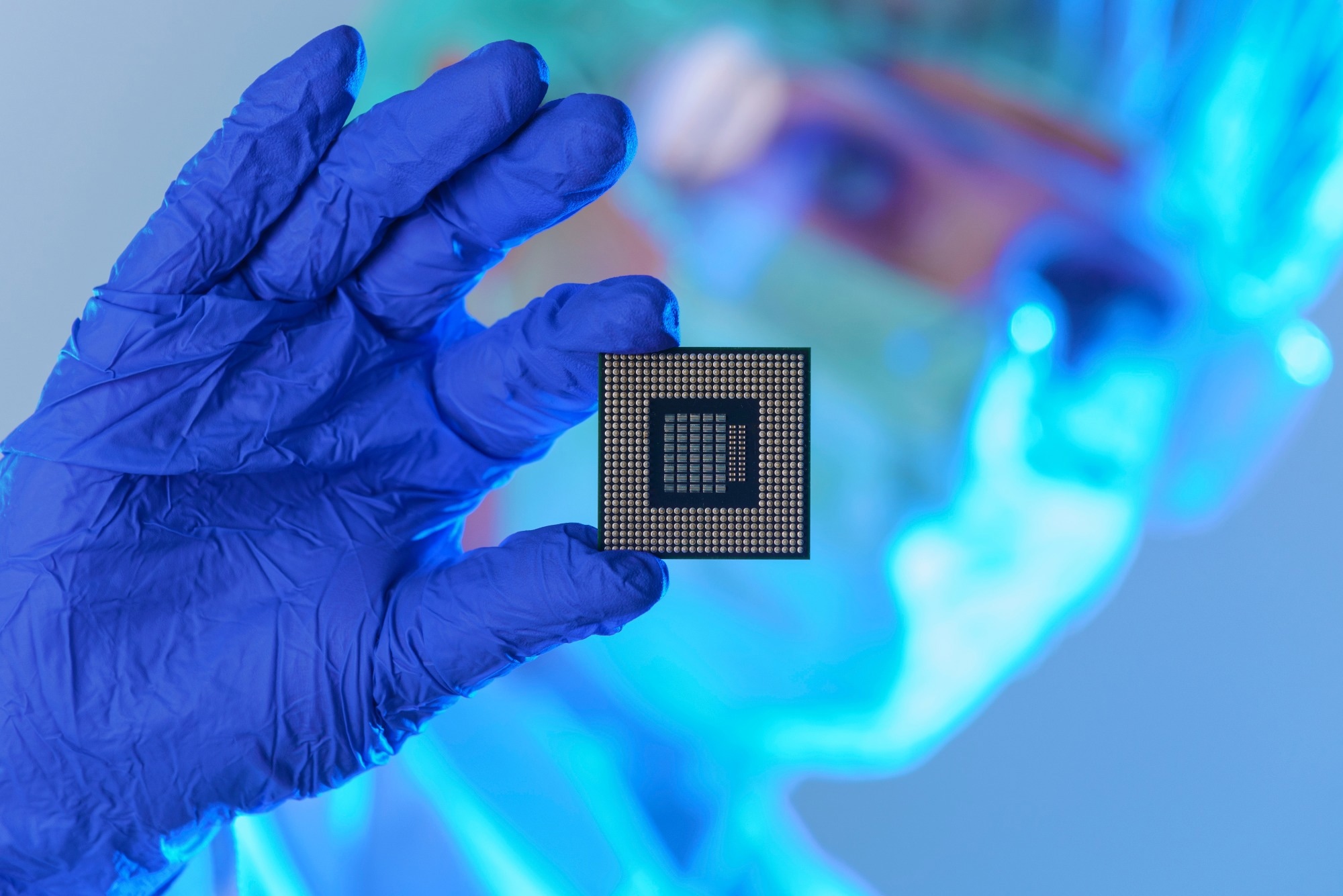 By Ankit SinghReviewed by Lexie CornerJul 8 2025
By Ankit SinghReviewed by Lexie CornerJul 8 2025Semiconductor chiplets represent an advancement in microchip design. They divide traditional monolithic systems into smaller, modular components.
Unlike traditional monolithic SoCs, which integrate all functions on one silicon die, chiplets separate system functions—such as compute, memory, and I/O—into specialized blocks.
This approach improves design flexibility, cost efficiency, and scalability, while helping to overcome the limits of Moore’s Law. As adoption grows in areas like AI, data centers, and high-performance computing, chiplets are reshaping how modern chips are built.

Image Credit: Monika Wisniewska/Shutterstock.com
The Rise of Modular Chip Design
A semiconductor chiplet is a modular, function-specific integrated circuit (IC) designed to operate with other chiplets in a single package.
Traditional monolithic system-on-chip (SoC) designs place all components—such as the CPU, GPU, and memory—on a single silicon die. Chiplets take a different approach by dividing these functions into smaller, specialized blocks.
These blocks are connected using advanced packaging technologies. This method allows for greater flexibility and scalability in chip design. It also supports customization for specific applications.1,2
Interest in chiplets has increased as Moore’s Law slows down. The continued shrinkage of transistors has become more difficult and costly. Chiplets offer a way to overcome these limits while maintaining improvements in computing performance.
Companies like AMD, Intel, and TSMC are leading this shift, with products such as AMD’s EPYC processors and Intel’s Ponte Vecchio GPU showcasing the potential of chiplets in high-performance computing (HPC) and artificial intelligence (AI).
By 2035, the global chiplet market is projected to reach $411 billion, driven by demand in data centers, AI, and automotive applications.3,4
Download your PDF copy now!
Comparison to Monolithic SoCs
Technical Limitations of Monolithic Designs
Traditional monolithic designs for SoCs integrate all essential components (logic, memory, and input/output (I/O)) onto a single die. This setup helps reduce latency and power consumption. However, it also introduces important limitations.
One major constraint is the reticle size, which restricts the maximum size of silicon dies due to the capabilities of photolithography equipment, thereby limiting the number of transistors that can be incorporated into a single chip.3
Larger dies also face lower manufacturing yields. A defect in any part of the die can make the entire chip unusable, increasing production costs.
Monolithic designs also encounter the "memory wall." They often cannot supply enough memory bandwidth to match processor speed. This leads to bottlenecks, particularly in data-intensive applications like AI training.2,3
How Chiplets Solve These Issues
Chiplets help overcome the limitations of traditional SoC designs by dividing them into smaller, specialized components. For example, a CPU chiplet can be built using a 3nm process to improve performance, while an I/O chiplet can use a more cost-efficient 16nm process.
This flexibility allows for heterogeneous integration, enabling the combination of chiplets from various manufacturers, such as an Intel CPU paired with TSMC memory, to create best-in-class solutions.1,2
Smaller chiplets also improve manufacturing yield. They are less likely to contain defects, which reduces waste. AMD reported a 70 % cost reduction by using chiplets in its EPYC processors.
Advanced packaging techniques, like TSMC’s Chip-on-Wafer-on-Substrate (CoWoS), facilitate swift communication between chiplets by positioning them on a silicon interposer, achieving speeds comparable to that of a single monolithic die.4,5
CHIPLETS: Divide and Conquer | The Future of Processors
Benefits of Semiconductor Chiplets
Scalability and Customization
Chiplets allow designers to scale systems by adding or swapping modules.
- AI Accelerators: NVIDIA’s Grace Hopper Superchip combines a CPU and GPU chiplet, tailored for AI workloads.6
- Edge Computing: Industrial Internet of Things (IIoT) devices use modular chiplets to balance power efficiency and processing needs.7
Cost Efficiency
Cost efficiency can be enhanced through the use of reusable intellectual property (IP), such as pre-validated chiplets from companies like Alphawave Semi, which reduces development time. Also, smaller chip designs make better use of wafer edges, minimizing waste typically found in traditional monolithic structures.6,8
Supply Chain Resilience
By sourcing chiplets from multiple suppliers (e.g., TSMC for logic, Samsung for memory), companies mitigate geopolitical risks and trade restrictions. China’s chiplet initiatives, for example, aim to circumvent U.S. sanctions on advanced nodes.7,9
Enabling Heterogeneous Integration
Chiplets excel in applications requiring diverse functionalities.
- High-Performance Computing (HPC): Intel’s Ponte Vecchio GPU integrates 47 chiplets, including compute, memory, and I/O tiles, to achieve exascale performance.4
- 5G Infrastructure: Chiplets combine radio frequency (RF), analog, and digital components in compact packages for low-latency communication.1
Challenges in Chiplet Adoption
Interconnect Standards
Seamless communication between chiplets requires standardized protocols. The Universal Chiplet Interconnect Express (UCIe), launched in 2022, aims to unify interfaces across vendors. However, adoption is still evolving, and competing standards complicate interoperability.7,9
Thermal Management
Densely packed chiplets generate significant heat. For example, AMD’s 3D V-Cache technology stacks SRAM chiplets vertically, requiring advanced cooling solutions to prevent thermal throttling. Materials like underfill polymers and copper hybrid bonding are being developed to enhance heat dissipation.3,9
Design Complexity
Due to the complex design, rigorous testing is essential, as each chiplet must be validated both individually and as part of the overall system. Advanced methodologies, such as built-in self-test (BIST) and hierarchical testing, play a crucial role in ensuring reliability.
Traditional electronic design automation (EDA) tools often struggle with the complexities of multi-die integration. Companies like Synopsys are developing tools to co-optimize chiplets and interconnects for enhanced performance.2,9
Talent and Supply Chain Gaps
The shift to chiplets demands expertise in advanced packaging and system-level design. A Deloitte report warns that 1.1 million semiconductor jobs could go unfilled by 2030 due to skill shortages.5
The Future of Chiplet Technology
Chiplets are changing how semiconductors are designed. They offer a solution as Moore's Law slows down. With chiplets, companies can customize their chips more easily, save money, and improve performance, especially for AI, high-performance computing, and edge computing. However, widespread adoption hinges on overcoming interoperability, thermal, and workforce challenges.
In the future, trends like 3D stacking and silicon photonics will improve chiplet systems. Alphawave Semi’s 1.6Tbps connectivity chiplet and the growing UCIe ecosystem show that chiplets will play a big role in chip design.
As the industry works together to create better standards and tools, chiplets will lead to new innovations. This will bring a new era of computing power and efficiency.2,6
Stay Ahead in Semiconductor Innovation
To keep up with the latest developments in chiplet architectures, advanced packaging, materials engineering, and semiconductor manufacturing breakthroughs, subscribe to our expert-curated Semiconductor Manufacturing & Analysis Newsletter.
References and Further Reading
- Microchip USA. (2023). What is a Chiplet? [Online] Microchip USA. Available at: https://www.microchipusa.com/industry-news/what-is-a-chiplet
- Synopsys. (nd). What is a Chiplet? [Online] Synopsys. Available at: https://www.synopsys.com/glossary/what-are-chiplets.html
- He, X. (2025). Chiplet Technology 2025-2035: Technology, Opportunities, Applications. [Online] IDTechEx. Available at: https://www.idtechex.com/en/research-report/chiplet-technology-2025/1041
- He, X. (2024). Chiplets: Revolutionizing Semiconductor Design and Manufacturing. [Online] IDTechEx. Available at: https://www.idtechex.com/en/research-article/chiplets-revolutionizing-semiconductor-design-and-manufacturing/32101
- Kusters, J. (2025). 2025 global semiconductor industry outlook. [Online] Deloitte Insights. Available at: https://www2.deloitte.com/us/en/insights/industry/technology/technology-media-telecom-outlooks/semiconductor-industry-outlook.html
- Stone, A. (2024). Chiplets and the future of high-performance computing and AI. [Online] DirectorsTalk. Available at: https://directorstalk.net/chiplets-and-the-future-of-high-performance-computing-and-ai
- Fleischer, A. J. (2024). Will 2025 Be the Year of the Chiplet? [Online] Octopart. Available at: https://octopart.com/pulse/p/year-of-the-chiplet
- Edge AI and Vision Alliance. (2025). Chiplet Technology: Unlocking New Potential in the Semiconductor Industry. [Online] Edge AI and Vision Alliance. Available at: https://www.edge-ai-vision.com/2025/01/chiplet-technology-unlocking-new-potential-in-the-semiconductor-industry/
- Schuett, L.-R. (2025). The Rise of Chiplets and Simplified Interconnectivity. [Online] IDTechEx. Available at: https://www.idtechex.com/en/research-article/the-rise-of-chiplets-and-simplified-interconnectivity/32779
Disclaimer: The views expressed here are those of the author expressed in their private capacity and do not necessarily represent the views of AZoM.com Limited T/A AZoNetwork the owner and operator of this website. This disclaimer forms part of the Terms and conditions of use of this website.